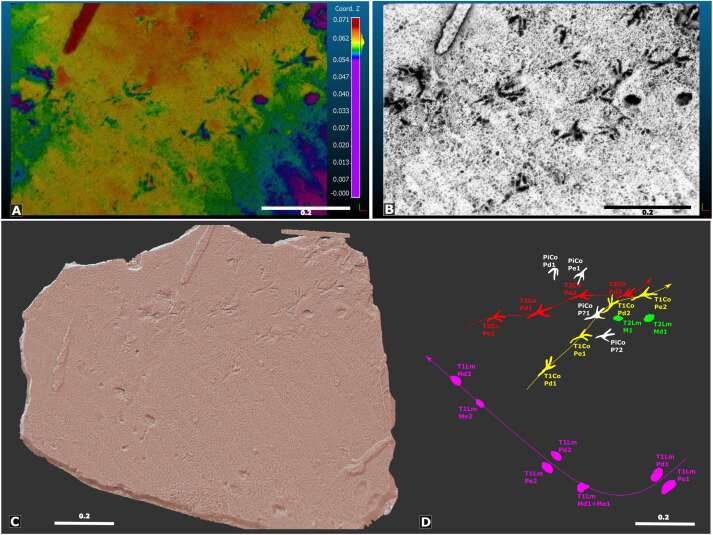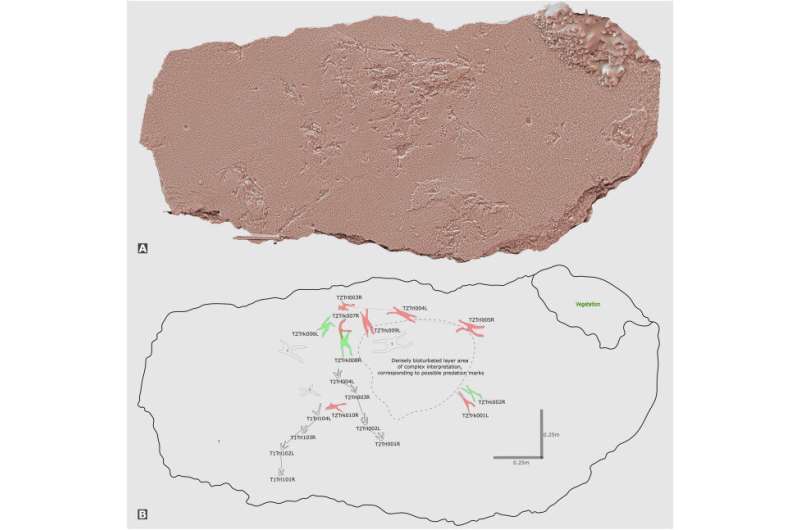July 18, 2023 feature
This article has been reviewed according to Science X's editorial process and policies. Editors have highlighted the following attributes while ensuring the content's credibility:
fact-checked
peer-reviewed publication
trusted source
proofread
Fossil trackways reveal first raptor-prey attack in Pleistocene Europe

Though we may often think of fossils purely as the bones of ancient organisms that roamed the Earth millions of years ago, in fact, we are actually able to see evidence of this past roaming itself.
Trace fossils, known as ichnotaxa, can reveal the movement of past life, showing distinct trackways that scientists can interpret as normal gait or increased locomotion (perhaps running to escape a predator or being the hunter themselves), the scuffle of animals interacting, resting traces where they break for a while perching or nesting, as well as the burrowing and boring activities of organisms dwelling in the sediment.
Like animals and plants, these distinctive trace fossils are given specific ichnogenus and ichnospecies names, which can quite often be linked to their creator.
Ichnofossils form when an impression is made in moist sediment, then dries out and is rapidly covered by more sediment, being buried and cemented over millennia, until the trackway is discovered, seeming as though it could have just been made.
New research, published in Quaternary Science Reviews, details rare bird ichnotaxa discovered on Pessegueiro island, Portugal. Within this coastal location, researchers at Naturtejo da Meseta Meridional UNESCO Global Geopark and their collaborators identified two new bird trackways: Corvidichnus odemirensis, attributed to the movement of a Western jackdaw (Corvus monedula), and Buboichnus vicentinus, interpreted as a predatory feeding trace of a Eurasian eagle-owl (Bubo bubo). The latter is considered to be one of, if not the first, evidence of a raptorial bird preying upon another animal preserved in a trace fossil.
Hailing from the Late Pleistocene (129,000 to 11,700 years ago) of Europe, the tracks were found in aeolianite sandstones (rocks made of wind-blown sand) from the Malhao Formation. The ichnofossils are preserved on the surface between beds of rock and here are exposed as waves crash into the cliffs and break off sections. Importantly, the site has to be surveyed on a regular basis otherwise the power of the ocean could erode away all of this fascinating insight into our planet's history. Alongside the avian tracks, the study area preserves ichnotaxa belonging to straight-tusked elephants, rabbits, red deer, foxes and Iberian lynx—a window into the larger ecosystem thriving at this time.
In order to study these impressive tracks, the researchers created 3D digital models based upon taking hundreds of photographs of the trace fossils in the field (a technique known as photogrammetry). Using specialist software, false colors can be used to highlight particular features of the trackways and enable measurements as well as interpretive reconstructions.
Measurements include the size of individual footprints and the paired trackways, length of each digit, angle between digits, divergence of each foot from the midline of the track, as well as the pace and stride length. All of this provides valuable data to interpret the style of locomotion—for example, when stride increases through the trackway, it indicates an increase in speed, which depending upon the creator could be an indication of running from a predator or progressing through a hunt preying on another individual.

One slab preserves footprints attributed to a perching bird (Western jackdaw), due to the distinctive digit formation, alongside a rabbit (see above image), with the paired tracks measuring an average 63 mm long and 39 mm wide. Four distinct digits are clear, with the bird walking at a slower pace towards the end of the trackway (marked in yellow), while the rabbit hops to change direction as the trackway curves. Western jackdaws have commonly been found in Portuguese caves dating from the Pleistocene and can still be seen today foraging on beaches and dunes.
The Buboichnus vicentinus impressions left by the Eurasian eagle-owl have a distinctive K or X shape known in arboreal (tree-dwelling) birds. The ichnofossil is more complex as the Buboichnus vicentinus trackway intersects two smaller trackways belonging to other birds. At the center of the slab, the sediment is so highly disturbed with overprinting of footsteps that interpretation of the individual trackways is challenging, but does lend weight to the fact the three trackways converge in the same area and so this may represent predator-prey interaction.
Though a million-year old hunt preserved in rock is fascinating, an important caveat is that it could be entirely coincidence and time may have passed between the smaller shorebirds visiting the area and the larger Eurasian eagle-owl roaming through. Today, the Eurasian eagle-owl is one of the largest owl species, with females being up to 75 cm, and claws are used for trapping prey as they use their feet to constrict them. Considering the footprints indicate an arboreal bird, it likely indicates a change in environmental conditions in the area, which currently experiences coastal lower-lying vegetation.
Perhaps next time you're walking along a beach and notice the footprints of seabirds in the sand, they could be the new ichnofossils of millennia to come.
More information: Carlos Neto de Carvalho et al, Coastal raptors and raiders: New bird tracks in the Pleistocene of SW iberian Peninsula, Quaternary Science Reviews (2023). DOI: 10.1016/j.quascirev.2023.108185
Journal information: Quaternary Science Reviews
© 2023 Science X Network





















